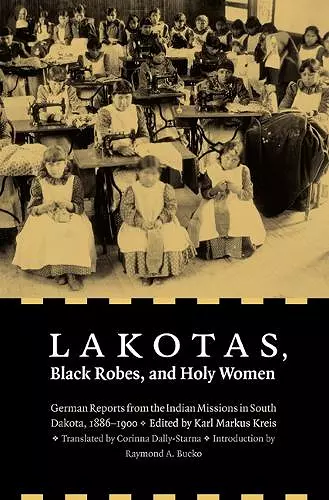Lakotas, Black Robes, and Holy Women
German Reports from the Indian Missions in South Dakota, 1886-1900
Corinna Dally-Starna translator Raymond A Bucko editor Karl Markus Kreis editor
Format:Paperback
Publisher:University of Nebraska Press
Published:1st Jan '10
Currently unavailable, and unfortunately no date known when it will be back

A rare collection of German eyewitness accounts of Lakota life, the Ghost Dance, and the Wounded Knee massacre in the late 19th century
Makes available in English a rare collection of eyewitness accounts by German Catholic missionaries among the Lakotas in the late nineteenth century. Although the accounts reflect the dominant perspective and attitude of missionaries and white teachers in the period of assimilation policy, they also offer firsthand accounts of the Lakotas in the early reservation years.Lakotas, Black Robes, and Holy Women makes available in English a rare collection of eyewitness accounts by German Catholic missionaries among the Lakotas in the late nineteenth century. German missionaries played an important role in the early years of the St. Francis mission on the Rosebud Reservation, and the Holy Rosary mission on the Pine Ridge Reservation, both in South Dakota. Although the accounts reflect the dominant perspective and attitude of missionaries and white teachers in the period of assimilation policy, they also offer firsthand accounts of the Lakotas in the early reservation years by Jesuits who saw themselves as friends and defenders of the Indians against a government policy they considered inappropriate and harmful. During the watershed years of 1886–1900, the German missionaries witnessed and participated in key events in the history of the American West, including the Ghost Dance, the Wounded Knee massacre, the Drexel Mission fight, the repression of Lakota rituals, and the growing importance of Catholicism for many Lakotas. The volume also describes the role of women in the mission and the process of converting and schooling Lakotas.
"With his collection of the reports of this specific group, Professor Kreis has submitted a valuable contribution to the field of German-American Studies."—Gert Niers, German Life
"Lakotas, Black Robes, and Holy Women makes an interesting contribution to Lakota history and gives readers a glimpse of early reservation life as seen through the eyes of German Jesuit priests and Franciscan nuns."—Brigit Hans, South Dakota History
"Anyone interested in Wounded Knee, turn-of-the-century life in the Great Plains, or the Lakotas will appreciate the book's primary sources."—Joshua M. Rice, Great Plains Quarterly
“Provides an intimate glimpse of what German Jesuit priests and Franciscan nuns encountered when they established missions among the Lakota (Sioux) during the early years of reservation life (documents dated from 1886 to 1901). . . . . [A] significant foray into literature that, until now, largely remains untapped. It will captivate those who seek to learn more about Lakota history, Catholic missionary efforts, and educational initiatives that held sway during a very stressful period of late-frontier history.”—American Catholic Studies
“What is unique about Kries’s collection is that many of the documents he includes are written by the Franciscan sisters. While many scholars who have examined these missions focused on the Jesuits’ perspective, Kreis’s inclusion of the Franciscan material lends a great deal of depth to his portrayal of the Lakota missions. Specifically, the Franciscan sisters provided detailed descriptions of the day-to-day life in the mission schedule and their impressions of the virtues and vices of the Lakota students. In summary, Kreis’s book is an excellent, well-composed, and carefully researched resource for anyone who is interested in the Lakota Sioux missions.”—Ross Enochs, Catholic Historical Review
ISBN: 9780803232747
Dimensions: unknown
Weight: unknown
340 pages